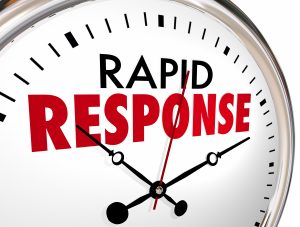BLOG
Please, Please, Please Let Me Get a Response! Best Practices for Rapid Response Pitching
By Patrick Reilly
We’ve all been there. The client has no upcoming announcements and the proactive pitches just aren’t hitting the mark. That doesn’t necessarily mean the pitch angles aren’t ideal or that the topics aren’t of interest, but as public relations professionals, we are in a results-oriented industry where it’s our job to deliver media opportunities and coverage.
In this scenario, the best option would be some good, old-fashioned rapid response pitching. For those unfamiliar with the term, rapid response pitching entails some due diligence in searching the internet to find relevant media coverage that aligns with your client’s industry or a particular pitch angle and, well, responding to them rapidly. This practice is a great way to build media lists and create new relationships while securing interviews and coverage. Here are a few tips to get the best results from your rapid response pitch:
 Track Your Client’s Keywords
Track Your Client’s Keywords
This can be achieved by using services like Google Alerts or Talkwater, where you set up alerts for keywords that are relevant to your clients. For example, if your client is focused on “Cloud Cost Management,” you should include everything that is related to this topic, which may include a broader term like “Cloud Computing” to something more niche like “Cloud Cost Optimization” or “Collaborative Cost Management.” Major players in this industry should also be included, such as “AWS” or “Azure” in this example, to see who is writing about these organizations.
You should also include your client’s top competitors in your search. These might actually end up being the “low-hanging fruit” in terms of getting interest from reporters. Rapid response presents an opportunity to reach out to editors and explain what your client is doing and how they are better, different, or deserve inclusion in future story ideas. In addition, you should also customize all of your alerts to get notified as soon as they happen – this way, you’re one of the first to get the hot news stories.
Check Media Alerts Often
PR professionals should start the workday by checking their media alerts and repeat the process throughout the day. While scanning keywords for proactive pitching, you can identify whether the article is a good fit, as you will quickly find that a good portion of articles that come through are not relevant or come from small outlets outside of your client’s target geographies.
If you find a great article from a desirable outlet, you then move on to the next step (see below for how to go get ‘em). Another avenue to consider is a simple Google Search on related topics and see what the media is writing about in the last month that might be worth some outreach.
Go Get ‘Em!
Ok, you identified a perfect article – so, now it’s actually time to respond. The subject line I like to use is a simple “In response to your recent article in the Wall Street Journal” or something more broad and ambiguous that is more likely to grab a reporters attention. They are getting hundreds of pitches a day, so a subject line that is not too specific might encourage them to open the email – especially when you are talking about something they already wrote. The best way to start an email is to politely touch the reporter or editor with a simple lede that starts off something like the example below:
Hi xx,
My name is Patrick Reilly and I help conduct the PR efforts for “Clients Name.” I notice that you recently wrote the article entitled “XYZ,” and I’d love to connect you with “Spokespersons name”, “Title” of “Clients Name” – “Clients Key Message” to talk about “pitch angle.”
After your intro, customize the rest of the pitch to fit the angle and make it more personal. Sometimes the article might follow exactly along the lines of the angle you are pitching, and the reporters might not be that interested in speaking to your client since they just wrote about that topic. In this situation, it is still a good idea to reach out, as the reporter might have a follow up story or want to keep your client on radar for any related stories they’re working on. With pitching, the worst answer you can get is “no” – but you can move on and find another article of relevance to rapid respond to.
Responding to Rapid Response
I think this might be the most overlooked part of rapidly responding to the media – forgetting to follow up with the initial email. It is a good idea to respond directly to the email you originally sent, which gives you a ‘second chance’ to send another broad and ambiguous subject line that references what the reporter already wrote. For example, the response email can look like the example below:
Hi xx,
Just bumping this email to the top of your inbox!
Let me know if you can set up a future call with “Spokesperson name” “title”, of “Companies Name” to discuss “relevant pitch angle” for a story idea. Let me know what time/date works best to schedule a call.
Let me know if you also might be working on future related stories where you can use “spokesperson’s name” as a source.
Thanks!
XX
I wouldn’t follow up more than once on a rapid response via email – but you can also call the reporter on the phone to follow up with a similar message. Since the first note is a rapid response, the follow up is more of a courtesy reminder, after that – you are just annoying the reporters.

Timing – How Soon Is Now?
The ultimate idea of rapid response pitching is exactly that – responding right when a news article is fresh. However, since we are not robots and because systems like Google Alerts are not always reliable, it’s not always possible to get to every relevant story immediately. Ideally, rapid responding to articles should be within a few hours to days after they run – but it’s ok to reach out as far as three months after the story has ran. This also depends on the angle you’re pitching and the story itself of course. If the original article is a feature on “sustainability in cloud management,” you have more time to respond. However, if it’s a major announcement from a company, I think two weeks might be the most time you have before it’s considered ‘old news.’
Rapid response pitching is a fantastic way to create new and strong media relationships, build media lists for reporters that might not be listed on Cision or other media monitoring platforms, and above all, get a new interview in a desirable outlet that will hopefully turn into coverage.
